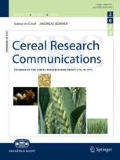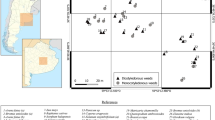Summary
Nine Fusarium graminearum isolates were investigated for their pathogenicity on wheat ears and zearalenone production. The investigated isolates originated from different geographical regions and included representatives of Group 1 and Group 2 of F. gramineraum species. Among these isolates significant differences in pathogenicity were found. Groups 1 and 2 included isolates with higher and lower pathogenicity. 44,4% of the isolates produced zearalenone in artificially infected wheat grains at concentrations ranging from 203 to 431 µg/kg. Isolates of both groups are capable of zearalenone synthesis.
Similar content being viewed by others
References
Aoki, T. and O’Donnell, K. (1999): Morphological and molecular characterization of Fusarium pseudograminearum sp. nov., formerly recognized as the Group 1 population of F. graminearum. Mycology, 91 (4), 597–609.
Atanassov, Z., Nakamura, C., Mori, N., Kaneda, C., Kato, H., Jin, Y., Yoshizava, T. and Murai, K. (1994): Mycotoxin production and pathogenicity of Fusarium species and wheat resistance to Fusarium head blight. Can. J. Bot. 72, 161–167.
Bagi, F. (1999): Testing the population heterogenicity of fungus Fusarium graminearum Schwabe pathogen of wheat and maize. University of Novi Sad, Master Sc. thesis, 1–131 (on Serbian language with English summary).
Bai, G.H. and Shaner, G. (1996): Variation in Fusarium graminearum and cultivar resistance to wheat scab. Plant Dis. 80, 975–979.
Balaž, F., Marić, A. and Marković, Ž. (1977): Influence of some agrotechnical measures on incidence and harmfulness of Fusarium stalk rot of maize. Zaštita bilja, 139 (1), 63–73.
Balmas, V., Corazza, L. and Santori, A. (1995): A comparison of the pathogenicity of F. graminearum Group 1, F. graminearum Group 2 and F. culmorum as casual agents of crown rot and head blight of wheat. International seminar on Fusarium mycotoxins, taxonomy and pathogenicity, Martina Franca, Italy, May 9–13., Book of Abstracts, 88–89.
Balzer, I., Bogdanić, C. and Pepeljnjak, S. (1978): Rapid thin-layer chromatographic method for determining aflatoxins, ochratoxin A and zearalenone. J. Assoc. of Anal. Chem. 61, 3–6.
Blaney, B.J. and Dodman, R.L. (1988): Production of the mycotoxins zearalenone, 4-deoxynivalenol and nivalenol by isolates of Fusarium graminearum Groups 1 and 2 from cereals in Queensland. Aust. J. Agric. Res., 39, 21–29.
Bottalico, A., Lerario, P. and Visconti, A. (1983): Production of mycotoxins (zearalenone, trichothecenes and moniliformin) by Fusarium species in Italy. Microbiologie-Aliments-Nutrition, 1, 133–142.
Bowden, R.L. and Leslie, J.F. (1994): Nitrate-nonutilizing mutants of Gibberella zeae (Fusarium graminearum) and their use in determining vegetative compatibility. Exp. Mycol. 16, 308–315.
Boyacioglu, D. and Hettiarachchy, N.S. (1995): Changes in some biochemical components of wheat grain that was infected with Fusarium graminearum. J. Cereal Science, 21, 57–62.
Burgess, L.W., Klein, T.A., Bryden, W.L. and Tobin, N.F. (1987): Head blight of wheat caused by Fusarium gramineamm Group 1 in NSW in 1983. Austral. J. Plant Path., 16, 72–78.
Burgess, L.W, Summereil, B.A., Bullock, S., Gott, K.P. and Backhouse, D. (1994): Laboratory manual for Fusarium research. University of Sydney and Royal Botanic Gardens, Sydney, 89–96.
Chelkowski, J. and Manka, M. (1983): The ability of Fusaria pathogenic to wheat, barley and corn to produce zearalenone. Phytopath. Z., 106, 354–359.
Che Tseng, T. (1993): Mycotoxin produced by Fusarium spp. of Taiwan. Bot.Bull.Acad.Sin. 34, 261–269.
Cullen, D., Caldwell, R.W. and Smalley, E.B. (1983): Susceptibility of maize to Gibberella ear rot: relationship to host genotype, pathogen virulence, and zearalenone contamination. Plant Dis. 67, 89–91.
Dexter, J.E., Clear, R.M. and Preston, K.R. (1996): Fusarium head blight: effect on the milling and baking of some Canadian wheats. Cereal Chem. 73 (6), 659–701.
Ehling, G., Cockburn, A., Snowdon, P. and Buschhaus, H. (1997): The significance of the Fusarium toxin deoxynivalenol (DON) for human and animal health. Cereal Res. Comm., 25, (3/1), 443–447.
Eudes, F., Collin, J., Rioux, S. and Comeau, A. (1997): The trichothecenes, a major component of wheat scab pathogenesis. Cereal Res. Comm., 25 (3), 1997.
Francis, R. G. and Burgess, L. W. (1977): Characteristics of two populations of Fusarium roseum ‘graminearum’ in eastern Australia. Trans. Br. Mycol. Soc. 68 (3) 421–427.
Gagkaeva, T. and Levitin, M. (1997): Composition of Fusarium graminearum Schwabe populations collected from different regions of Russia. Cereal Res. Comm., 25, (3/2), 591–593.
Gang, G., Miedaner, T., Schuhmacher, U., Schollenberger, M. and Geiger, H.H. (1998): Deoxynivalenol and nivalenol production by Fusarium culmorum isolates differing in aggressiveness toward winter rye. Phytopathology, 88, 879–884.
Ichinoe, M., Kurata, H., Sugiura, Y. and Ueno, Y (1983): Chemotaxonomy of Gibberella zeae with special reference to production of trichothecenes and zearalenone. Appl. Environ. Microbiol. 46, (6), 1364–1369.
Logrieco, A., Bottalico, A. and Altomare, C. (1988): Chemotaxonomic observations on zearalenone and trichothecene production by Gibberella zeae from cereals in southern Italy. Mycologia, 80 (6), 892–895.
Logrieco, A., Manka, M., Altomare, C. and Bottalico, A. (1990): Pathogenicity of Fusarium graminearum chemotypes towards corn, wheat, triticale and rye. J. Phytopathology 130, 197–204.
Maier, F.J. and Oettler, G. (1996): Genetic variation for head blight resistance in triticale caused by Fusarium graminearum isolates of different deoxynivalenol production. Euphytica, 89, 387–394.
Mesterházy, Á. (1989): Progress in breeding of wheat and corn genotypes not susceptible to infection by Fusaria. In: Fusarium, mycotoxins, taxonomy and pathogenicity. Ed.: Chelkowski, J. Elsevier, Amsterdam, 357–386.
Miedaner, T. and Schilling, A. G. (1996): Genetic variation of aggressiveness in individual field population of Fusarium graminearum and Fusarium culmorum tested on young plants of winter rye. Eur. J. Plant Pathology, 102, 823–830.
Miedaner, T. (1997): Breeding wheat and rye for resistance to Fusarium diseases-review. Plant Breeding, 116, 201–220.
Miller, J.D., Taxlor, A. and Greenhalgh, R. (1983): Production of deoxynivalenol and related compounds in liquid culture by Fusarium graminearum. Can. J. Microbiol., 29, 1171–1178.
Miller, J.D., Greenhalgh, R., Wang, Y.Z. and Lu, M. (1991): Trichothecene chemotypes of three Fusarium species. Mycologia, 83, 121–130.
Milus, E.A. and Parsons, C.E. (1994): Evaluation of foliar fungicides for controlling Fusarium head blight of wheat. Plant Dis. 78, 697–699.
Mirocha, C.J., Abbas, H.K., Windeis, C.E. and Xie, W. (1989): Variation in deoxynivalenol, 15-acetyldeoxynivalenol, 3- acetyldeoxynivalenol, and zearalenone production by Fusarium graminearum isolates. Appl. Environ. Microbiol., 55 (5), 1315–1316.
Moraru, I., Ittu, M. and Ciocazan, I. (1997): In vitro response to Fusarium toxin (ZEN) of some winter wheat and maize genotypes. Cereal Res. Comm., 25, (3/1), 503–505.
Parry, D. W., Jenkinson, P., McLeod, L. (1995): Fusarium ear blight (scab) in small cereals — a review. Plant Pathology, 44, 207–238.
Pinero, M.S., Scott, P.M. and Kanhere, S.R. (1996): Mycotoxin producing potential of Fusarium graminearum isolates from Uruguayan barley. Mycopathologia, 132, 167–172.
Schilling, A., G, Möller E., M. and Geiger, H. H. (1996): Molecular differentiation and diagnosis of the cereal pathogens Fusarium culmorum and F. graminearum. Sydowia, 48 (1), 71–82.
Shimada, T. and Otani, M. (1990): Effects of Fusarium mycotoxins on the growth of shoots and roots at germination in some Japanese wheat cultivar. Cereal Res. Comm., 18 (3), 229–232.
Summereil, B. A., Burgess, L.W., Klein, T.A. and Pattison, A. B. (1990): Stubble management and the site of penetration of wheat by Fusarium graminearum Group 1. Phytopathology, 80, 877–879.
Sutton, J. C. (1982): Epidemiology of wheat head blight and maize ear rot caused by Fusarium graminearum. Can. J. Plant Path., 4, 195–209.
Szécsi, Á (1990): Fusariotoxins. Növénytermelés, 39 (4), 369–379.
Szécsi, Á. (1995): Trichotecene chemotypes of Fusarium graminearum isolates from com in Hungary. Növényvédelem, 31 (3) 103–109.
Szuets, P., Mesterházy, Á., Falkay, Gy., and Bartók, T. (1997): Early telarche symptoms in children and their relation to zearalenon contamination in foodstuffs. Cereal Res. Comm., 25, (3/1), 429–436.
Tomasović, S. (1991): Breeding wheat for resistance to Fusarium disease on spike (head blight). Sjemenarstvo, 8 (9), 67–76.
Vianello, A. and Macri, F. (1978): Inhibition of Plant Cell Membrane Transport Phenomena Induced by Zearalenone (F-2). Planta 143, 51–57.
Wong., L.S.L., Abramson, D., Tekauz, A., Leisle, D. and McKenzie, R.I.H. (1995): Pathogenicity and mycotoxin production of Fusarium species causing head blight in wheat cultivars varying in resistance. Can. J. Plant Sci., 75, 261–267.
Wolf, J.C. and Mirocha, C.J. (1973): Regulation of sexual reproduction in Gibberella zeae (Fusarium roseum ‘Graminearum’) by F-2 (Zearalenone). Can. J. Microbiol. 19, 725–734.
Author information
Authors and Affiliations
Rights and permissions
About this article
Cite this article
Bagi, F., Balaž, F. & Marija, Š. Pathogenicity and Zearalenone Production by Different Fusarium graminearum Isolates in Artificially Infected Wheat Grain. CEREAL RESEARCH COMMUNICATIONS 28, 477–484 (2000). https://doi.org/10.1007/BF03543632
Received:
Accepted:
Published:
Issue Date:
DOI: https://doi.org/10.1007/BF03543632




